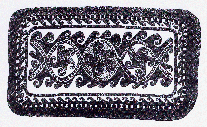|
Felting
between East and West
Murray Lee Eiland III
Introduction
When appreciating the art of a particular
culture, one can be struck either by
differences or the similarities. After even
a cursory examination of modern felts made
in Hungary and Turkmenistan, the
similarities are overwhelming (Figs 1-2).
Not only the arrangement of the main
elements, but the “spirals and waves” leave
little doubt of a connection. When
considering the distances between these two
areas, this observation may support parallel
development in two separate areas. Yet even
at first glance the designs are so similar
as to warrant careful consideration. While
the Hungarians have long ago given up a
nomadic existence, and the Turkmen are
rapidly doing so, these two peoples may
share more than their different lineages
suggest. This is all the more important as
it is clear that Turks were an important
part of the peoples who emigrated into the
area of modern Hungary during the collapse
of Byzantine power in the region (Horváth
1989: 27).

Whatever the case for
particulars of ethnic identity , it is clear
that the peoples of the steppes shared many
aspects of material culture. Felting, unlike
weaving, is relatively simple, and does not
constrain the art enough to dictate the form
of decorative patterns. In this case the
natural environment may almost necessitate
aspects of material culture which are
important for survival.
A great distance - in the range of 1000 km -
could be seen as a barrier, but when the
geography and history of this vast region
are taken into account, these two points at
geographical extremes could reflect the ends
of a conduit. From the Balkans to Eastern
Central Asia stretched a vast plain that
has, at various times, hosted nomads with a
distinctive material culture. While the
ethnic identities of these nomads have
varied, they all shared the need for
mobility, and all were concerned with animal
husbandry. Their arts reflects these
concerns. While nomads have traditionally
been associated with animals, it is no
surprise that they are also major suppliers
of wool, which could be converted into
fabrics. If a nomadic group moves from place
to place, they may not use the highest
technology (such a weaving) to produce the
finest fabrics, but, instead, rely upon
those skills required for survival in a
continental environment of extremes. Felting
may not be the ideal method for producing
lavish fabrics for a court, but it has been
a vital aspect of living a mobile life on
the steppes.
Felt is quite probably the earliest fabric
exploited by early humans. With the
domestication of sheep - associated with the
rise of farming communities during the so
called agricultural revolution of c. 10,000
B.C. - animal skins were no doubt used for
matting and clothing. Anyone who used skins
would be familiar with matted hair from
continued use, and even more convincing,
during moulting (modern breeds no longer
moult, but their hairs can still become
matted) primitive sheep have hairs that
intertwine naturally as the underwool and
the outer hairs become entangled. In
antiquity this trait was no doubt
recognized, and soon there would have been
some sense of economy. Unlike an animal that
was hunted, sheep under one’s care would be
worth considerably more if only renewable
resources were obtained from the animal.
Shearing sheep would lead to larger flocks
and greater wealth. Leather would also be
easier to use for a variety of products
without hair. It is with these two
observations in mind that one may appreciate
the legends that are associated with
felting. From the occident, Saint Clement is
credited in the first century A.D. with
‘discovering’ felting after placing wool in
his sandals during a journey. Afterwards, he
noted that the fibres had become enmeshed. A
similar story from a Near Eastern
perspective is that Arab camel drivers used
camel hair to cushion their feet (Ryder
1989: 45).
In both stories, felted
fibres are clearly understood to result from
moisture and motion. It is also interesting
to note that legends of woven fabrics, when
they are told in Eurasian societies, are
usually focussed upon the more distant past.
Felting, perhaps because there are at any
given time few old felts in circulation, is
in the popular imagination regarded as being
a more recent invention than weaving.
|



